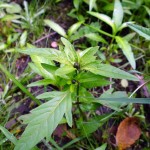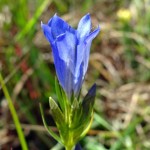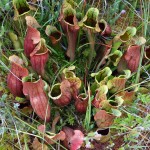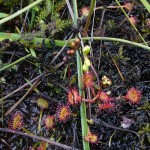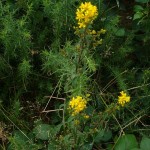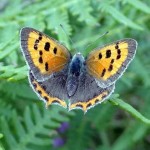Renée Grayer led a walk, attended by 16 members and friends, at Chobham Common on the morning of Saturday 23rd August. Owned by Surrey County Council and managed by Surrey Wildlife Trust, it is the largest National Nature Reserve in South-east England. The site is a lowland heath area of 585 hectares with some 60 ponds. It is rich in plants, birds, reptiles, amphibians, butterflies and other insects, with the wetland heath particularly interesting from a botanical and wildlife point of view. One of the big problems in the recent years has been the increase in Purple Moor-grass, partly due to increased nutrient levels. Cattle have been introduced in specific areas in the hope that grazing will diminish this problem. The group started from the car park at the junction of the B386 and B383, setting out in a northerly direction towards the Monument. Half way there was an interesting bog containing Water-pepper Persicaria hydropiper, Gypsywort Lycopus europaeus, Tufted Forget-me-not Myosotis laxa, Trifid Bur-marigold Bidens tripartite and Marsh Cudweed Gnaphalium uliginosum. On the Northern slope from the Monument, four specimens of the rare Marsh Gentian Gentiana pneumonanthe were seen and keenly photographed. In this area three different species of heather were flowering, Bell Heather Erica cinerea, Cross-leaved Heath Erica tetralix and Heather Calluna vulgaris. Tormentil Potentilla erecta was also seen here. The route then led towards the North-west of the Reserve. On the right of the path was another pond, which contained much Marsh Pondweed Potamogeton polygonifolius, and along the edge Lesser Spearwort Ranunculus flammula was flowering. Further along the path were Marjoram Origanum vulgare, Water Mint Mentha aqauatica and Germander Speedwell Veronica chamaedrys, not flowering, but with white galls on top of the plants, in which there were tiny orange grubs. A red gall was growing on Dog Rose Rosa canina, the well-known Robin’s pincushion. Sally Rankin pointed out a small pink knapweed-like flower, Saw-wort Serratula tinctoria. At the end of the path was a large swamp with Marsh Pennywort Hydrocotyle vulgaris growing on the edge. Swallows Hirundo rustica were flying over the water.
Harry Matthews then led the group eastwards to a bog containing two different species of Pitcher plant, the red Sarracenia purpurea and yellow-green S. flava, insect-eating species that had been introduced from Northern America, but according to Harry they had been growing there for at least 30 years. One of our native insect-eating plants was also growing there abundantly, the Round-leaved Sundew, Drosera rotundifolia. The bog also contained much Bog Asphodel Narthecium ossifragum, not flowering but showing conspicuous orange-brown fruits, and Cotton-grass Eriophorum angustifolium with fluffy white tops. The group walked back towards the Monument and then took the main path leading north-eastwards to see several of patches of our native Goldenrod Solidago virgaurea. Along a side path was another pond. This contained Bogbean Menyanthes trifoliate and Bulrush Typha latifolia. A little further on were a beautiful specimen of the Common Centaury Centaurium erythraea in flower and many plants of Perforate St John’s-wort Hypericum perforatum in fruit. Other plants in the area included Redshank Persicaria maculosa, Devil’s-bit Scabious Succisa pratensis and Broad-leaved Helleborine Epipactis helleborine. In the drier areas with heather and gorse (both Ulex europaeus and U. minor), were a number of Grayling butterflies Hipparchia semele, some flying, whereas others were lying on the ground with closed wings, perfectly camouflaged. A beautiful Small Copper butterfly Lycaena phlaeas had been seen earlier in the day. A number of Stonechats Saxicola torquata were seen on top of the gorse bushes. A narrow path with another interesting pond, which contained amongst others the rare White Beak-sedge Rynchospora alba, led the group back to the car park.
Report by Renée Grayer
Pictures by Chris Ash
| Species observed in Chobham Common 23 Aug. 2014 | |
| Scientific names | Common names |
| Plant species: | |
| Bidens tripartita | Trifid Bur-marigold |
| Calluna vulgaris | Heather |
| Centaurium erythraea | Common Centaury |
| Cirsium palustre | Marsh Thistle |
| Cytisus scoparius | Broom |
| Drosera rotundifolia | Round-leaved Sundew |
| Epipactis helleborine | Broad-leaved Helleborine |
| Erica cinerea | Bell Heather |
| Erica tetralix | Cross-leaved Heath |
| Eriophorum angustifolium | Common Cottongrass |
| Gentiana pneumonanthe | Marsh Gentian |
| Gnaphalium uliginosum | Marsh Cudweed |
| Hydrocotyle vulgaris | Marsh Pennywort |
| Hypericum perforatum | Perforate St John’s-wort |
| Hypochaeris radicata | Cat’s-ear |
| Juncus tenuis | Slender Rush |
| Lotus corniculatus | Common Bird’s-foot-trefoil |
| Lotus pedunculatus | Greater Bird’s-foot-trefoil |
| Lycopus europaeus | Gypsywort |
| Mentha aquatica | Water Mint |
| Menyanthes trifoliata | Bogbean |
| Molinia caerulea | Purple Moor-grass |
| Myosotis laxa | Tufted Forget-me-not |
| Narthecium ossifragum | Bog Asphodel |
| Origanum vulgare | Marjoram |
| Persicaria hydropiper | Water-pepper |
| Persicaria maculosa | Redshank |
| Potamogeton polygonifolius | Bog Pondweed |
| Potentilla erecta | Tormentil |
| Pteridium aquilinum | Bracken |
| Ranunculus flammula | Lesser Spearwort |
| Rhynchospora alba | White Beak-sedge |
| Sarracenia flava | Trumpets |
| Sarracenia purpurea | Pitcherplant |
| Senecio jacobaea | Common Ragwort |
| Serratula tinctoria | Saw-wort |
| Solanum dulcamara | Bittersweet |
| Solidago virgaurea | Goldenrod |
| Succisa pratensis | Devil’s-bit Scabious |
| Typha latifolia | Bulrush |
| Ulex europaeus | Gorse |
| Ulex minor | Dwarf Gorse |
| Veronica chamaedrys | Germander Speedwell |
| Bird species: | |
| Hirundo rustica | Swallow |
| Saxicola turquata | Stonechat |
| Butterfly species: | |
| Hipparchia semele | Grayling |
| Lycena phlaeas | Small Copper |
List by Renée Grayer

